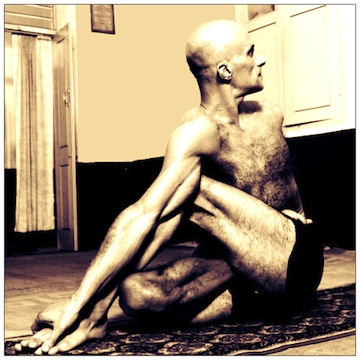Authorized Ashtanga yoga teacher Paul Mitchell Gold of the Ashtanga Yoga Shala, Toronto writes on the healing power of a daily Mysore practice and how to work with injuries. (See also "Should I Practice If...?")
Healing Injuries with Ashtanga Yoga
Originally published September 22, 2012, Ashtanga Yoga and other things
Republished with permission
Originally published September 22, 2012, Ashtanga Yoga and other things
Republished with permission
Yoga practice is not an exercise class and
it’s not a workout. Sure, it’s vigorous and physically challenging, but
that’s just the means rather than the end. However, as with any physical
endeavour, aches and pains are unavoidable and injuries can happen.
If one gets injured practicing yoga, the
yoga practice is the best way to heal and rehabilitate. Also, if one
gets injured doing some other activity, yoga practice is the best way to
heal and rehabilitate. Finally, if one begins yoga practice with a
preexisting injury, the yoga practice is the best way to heal and
rehabilitate. From my experience, yoga practice is an amazing healer.
Healing an injury with Ashtanga Yoga is
possible and requires daily practice. Taking days off regardless of how
one’s feeling is ultimately detrimental to the healing process. Unlike
working out, the effects of yoga practice are cumulative. The body’s
natural reaction to injury is to contract and armour. Yoga encourages
the afflicted area to move when it wants to petrify. Taking days off
between practices just makes the body stiffer under normal
circumstances, but even more so with an injury or chronic condition.
Students often wait until their aches and
pains are gone before returning to class. They’ll disappear and return
saying they needed to rest their injury. The truth, however, is that the
pain is not gone and the injury hasn’t healed. The problem simply went
underground while they were resting and was patiently waiting to return.
Whatever imbalance or bad habit caused the pain or injury hasn’t been
addressed or corrected. The pains and injury return as soon as the
student is back on the mat.
It is a shame that some students who aren’t
willing to follow the prescription for daily practice end up quitting
and saying that “ashtanga yoga doesn’t work” or “yoga made my pain
worse.” This just isn’t true.
The first thing a student must do when using
the practice to heal and rehabilitate is adapt. It is necessary when
injured to scale back practice so that it’s appropriate as therapy. That
very often means having a very basic and short practice for awhile
where the level of sensation to the injured area is deliberately kept at
zero.
Both Rachelle and I have had pain and
injuries over the years and we both used ashtanga yoga as a means of
healing ourselves. Some days, I would do only a few slow and difficult
sun salutations before needing to stop. It had it’s moments of
frustration and I often felt impatient and frankly pissed off. It wasn’t
much fun, but I slowly healed and was back to 100% over time.
So, first off, a student needs to adjust
practice to reflect the injury or pains being experienced. There’s no
reason to power through or ignore the problem. In the case of an injury
caused by bad habits or poor breathing, taking things slowly and scaling
back helps to pinpoint where there’s a problem and re-learn how to
practice correctly without causing chronic pain. One of the added
bonuses of using practice to heal an injury is that we find practice is
stronger once we’ve healed.
In the case of a student who starts ashtanga
yoga to heal a pre-existing injury, the best advice I can give is to
look at practice as medicine and follow the prescription.
If I were to develop a chest infection and
went to a doctor, I would likely be prescribed antibiotics to treat the
infection with instructions to take three pills every day for a week. If
I follow the prescription, I will no longer have my chest infection
However, if I do NOT follow the prescription and I take the medicine
every few days or only once per day, I really shouldn’t be surprised if
my problem hasn’t been cured.
Practice daily. Do what you can. Don’t push.
Maintain zero sensation in the injured area. Be patient and have faith.
Talk to your teacher when you’re frustrated. This is the prescription
to heal injuries using ashtanga yoga. Students who follow this
prescription heal their injuries and rehabilitate chronic problems. They
transform their bodies and blow their minds in the process.
About Paul
I took my first yoga classes in 1995 and became a dedicated practitioner of Ashtanga Yoga after a short period of experimenting.
I took my first yoga classes in 1995 and became a dedicated practitioner of Ashtanga Yoga after a short period of experimenting.
From 1998 to 2001, I studied with Noah
Williams and Kimberly Flynn and taught at their yoga school in Los
Angeles. I also want to thank Jorgen Christiansson, an early teacher and
good friend, who first taught me to trust this practice.
In 2001, Rachelle and I made our first trip to
Mysore, India. Since, we have returned annually to continue our studies
with Guruji and Sharath.
I received authorization
to teach the Ashtanga method in 2004 and was a member of the first
group to receive Level 2 Authorization in July 2009. I have the blessing
of KPJAYI to teach students the full Primary and Intermediate Series of Ashtanga Yoga.
Dedication to daily practice is the
cornerstone of my teaching philosophy. I encourage my students to
develop the virtues of patience, faith, diligence, compassion and
non-attachment using the integrity and genius of the traditional
Ashtanga system. As these virtues are cultivated over time, students are
well on the way to living fuller, happier and more balanced lives. More












